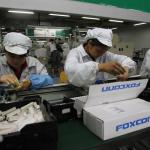Luz Sosa: Take Off the Rose-Colored Glasses about Foxconn

If it sounds too good to true, you can bet it is. Notorious Taiwanese manufacturer Foxconn is setting Wisconsin up for a hustle, and the very people who should be suspicious — news media and politicians — are playing right into Foxconn’s hands.
Journal Sentinel reporter John Schmid breathlessly writes that a Foxconn investment could result in employment of “staggering proportions.” In debate over the state budget, Assembly Speaker Robin Vos throws around “10,000 jobs” that Foxconn could create.
How about a cold shower and some due diligence? Here’s Foxconn’s record of failed promises:
• Foxconn promised a $30 million factory employing 500 workers in Harrisburg, Pennsylvania, in 2013. The plant was never built, not a single job was created.
• That same year, the company signed a letter of intent to invest up to $1 billion in Indonesia. Nothing came of it.
• Foxconn announced it would invest $5 billion and create 50,000 jobs over five years in India as part of an ambitious expansion in 2014. The investment amounted to a small fraction of that, according to The Washington Post’s Todd Frankel.
• Foxconn committed to a $5 billion investment in Vietnam in 2007, and $10 billion in Brazil in 2011. The company made its first major foray in Vietnam only last year. In Brazil, Foxconn has an iPhone factory, but its investment has fallen far short of promises.
• Foxconn recently laid off 60,000 workers, more than 50 percent of its workforce at its IPhone 6 factory in Kushan, China, replacing them with robots that Foxconn produces.
If Foxconn establishes production in Wisconsin it will be in a highly automated capital-intensive facility that would not create anywhere near the number of jobs being bandied about. CEO Terry Gou clearly stated, "Automation, software and technology innovation will be our key focus in the U.S. in the coming few years.”
Here’s reality: Cyber component manufacturing with large numbers of employees has mainly occurred in low-wage, marginally regulated countries. Wisconsin can’t and shouldn’t compete with Vietnam and China for the lowest wages and intolerable working conditions.
However, Foxconn has reasons to want a U.S. plant: as a savvy political response to Trump’s threat to impose tariffs on foreign-made goods, and to fend off pressure being applied to companies like Apple that have been harshly criticized for doing business with Foxconn because of its abhorrent and exploitative working conditions.
The question for us in Wisconsin is: Under what conditions do we want Foxconn? Because the whole reason the company’s executive jet landed here is to play us off against other states to get the hugest public subsidies and make the smallest investment possible.
To answer, politicians and media must take off the rose-colored glasses. If Foxconn builds a factory, it will employ not thousands of workers but rather dozens or hundreds of skilled technicians operating robots. Trump’s projection of 50,000 workers is no more accurate than his claim about the number of attendees at his inauguration. And Foxconn will demand hundreds of millions of dollars in public subsidies.
We’ve been down this road before. Remember when GM cynically played 24 states against each other to see who could provide GM with the most public money for its Saturn plant? Tennessee won with a public subsidy of $240 million, $26,000 per job.
A decade later Mercedes selected Alabama for a new plant. But it cost the state dearly. Tax breaks and other subsidies were close to $300 million, almost $200,000 for each job.
If the past experience is a guide, Gov. Walker and company will be happy to fork over billions of dollars or more to Foxconn for its promises. The Wisconsin Economic Development Corporation’s sordid lack of accountability on subsidies demonstrates that the current GOP legislative majority couldn’t care less about requiring recipient firms to create any jobs.
So that challenges citizens and the media to insist on strict requirements before any Foxconn subsidy:
1. Foxconn must identify the specific number of jobs it will create and sustain for a minimum of five years.
2. If it fails to deliver, there must be a “clawback” provision requiring this multibillion-dollar corporation to pay back the state or local government that financed the investment.
3. Using the Milwaukee Bucks arena development as a model, require the firm to pay all of its employees $15 an hour or more.
Of course, during negotiations Foxconn will claim it can get a better deal in another state. If that’s true, let somebody else be the sucker. Wisconsin’s hardworking people deserve a real bang for their bucks.
Luz Sosa of Milwaukee is an adjunct economics instructor at Milwaukee Area Technical College.
